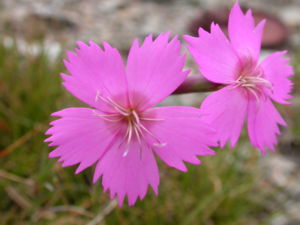Stone carnation
| Stone carnation | ||||||||||||
|---|---|---|---|---|---|---|---|---|---|---|---|---|

Stone carnation |
||||||||||||
| Systematics | ||||||||||||
|
||||||||||||
| Scientific name | ||||||||||||
| Dianthus sylvestris | ||||||||||||
| Wulfen |
The stone carnation ( Dianthus sylvestris ), in Austria z. Sometimes also called wild carnation , is a carnation family (Caryophyllaceae). It is rare and particularly protected according to the Federal Species Protection Ordinance (BArtSchV).
description
The stone carnation is a perennial, wintering green hemicryptophyte . It reaches heights of between 10 and 30 centimeters. It forms cushion-like lawns. The simple or upward branching stems are bare. The dark green, narrowly linear and runny leaves reach 2 to 4 centimeters in length.
The flowers are red to reddish-purple. The mostly two calyx scales (cf. carnations ) are broadly ovoid and suddenly pointed. The chalice is between 20 and 25 millimeters long and is four times as long as the chalice scales. The bald plate of the petals is 10 to 12 millimeters long, serrated at the front and without any markings.
The stone carnation blooms from June to early September.
The number of chromosomes of the species is 2n = 30 or approx. 60.
Distribution and location
The stone carnation is common in Central and Southern Europe and North Africa. It grows on sunny slopes, stony embankments, on rock mats and in crevices on permeable, base-rich, humus-rich stone or rock soils in subalpine to alpine altitudes between 1600 and 2800 meters. It is a Sedo-Scleranthetalia order character, but also occurs in Seslerietea or Festuco-Brometea societies.
In Germany it occurs in the Allgäu Alps . Here it rises from 790 m at the foot of the Auer Fluh in Vorarlberg to 2270 m above sea level (in the Tyrolean part on the southeast ridge of the Rothornspitze on Hornstein). It also occurs in places in the High Taunus.
ecology
It is mainly pollinated by moths of the genus Hadena , which also lay their eggs in the buds of the stone carnation. He is not very picky about partner choice.
Systematics
The species was described for the first time in 1787 by Franz Xaver von Wulfen .
The following subspecies are distinguished:
- Dianthus sylvestris subsp. aristidis (Batt.) Greuter & Burdet : The homeland is Algeria.
- Dianthus sylvestris subsp. bertisceus Rech. f. : The home is Albania and Macedonia.
- Dianthus sylvestris subsp. longibracteatus (Maire) Greuter & Burdet : The homeland is Morocco.
- Dianthus sylvestris subsp. longicaulis (Ten.) Greuter & Burdet (Syn .: Dianthus godronianus Jord. ): The homeland is Spain, France, Italy, Morocco, Algeria and Tunisia. The number of chromosomes is 2n = 30.
- Dianthus sylvestris subsp. nodosus (exchange) Hayek : Home is Croatia, Albania and Greece.
- Dianthus sylvestris subsp. siculus (C. Presl) Tutin : The homeland is Spain, France, Italy, Morocco, Algeria and Tunisia.
- Dianthus sylvestris subsp. sylvestris : The home is Central and Southern Europe.
- Dianthus sylvestris subsp. tergestinus (Rchb.) Hayek : The homeland is Albania, Croatia and eastern Italy.
Common names
For the stone carnation the other German-language trivial names exist or existed : Steinnägali ( St. Gallen , Bern ) and Steinnagl ( Carinthia , Pinzgau ).
Sources and further information
literature
- Werner Rothmaler (Ed. Von Eckehart J. Jäger and Klaus Werner): Vascular plants, basic volume. Excursion flora of Germany, Vol . 2 . ISBN 978-3-8274-1600-1 .
- Henning Haeupler , Thomas Muer: picture atlas of the fern and flowering plants of Germany (= the fern and flowering plants of Germany. Volume 2). Published by the Federal Agency for Nature Conservation. Ulmer, Stuttgart 2000, ISBN 3-8001-3364-4 .
- Erich Oberdorfer : Plant-sociological excursion flora. Ulmer, Stuttgart 1994. ISBN 3-8252-1828-7
- Peter Schönfelder , Andreas Bresinsky: Distribution atlas of the fern and flowering plants of Bavaria . Ulmer, 1990. ISBN 3-8001-3455-1
- Manfred A. Fischer , Karl Oswald, Wolfgang Adler: Excursion flora for Austria, Liechtenstein and South Tyrol. 3rd, improved edition. State of Upper Austria, Biology Center of the Upper Austrian State Museums, Linz 2008, ISBN 978-3-85474-187-9 .
Individual evidence
- ↑ a b Erich Oberdorfer : Plant-sociological excursion flora for Germany and neighboring areas . 8th edition, page 369. Stuttgart, Verlag Eugen Ulmer, 2001. ISBN 3-8001-3131-5
- ↑ a b according to Germplasm Resources Information Network (GRIN) [1]
- ↑ Erhard Dörr, Wolfgang Lippert : Flora of the Allgäu and its surroundings. Volume 1, IHW, Eching 2001, ISBN 3-930167-50-6 , pp. 482-483.
- ↑ Dianthus sylvestris subsp. garganicus at Tropicos.org. In: IPCN Chromosome Reports . Missouri Botanical Garden, St. Louis
- ^ Georg August Pritzel , Carl Jessen : The German folk names of plants. New contribution to the German linguistic treasure. Philipp Cohen, Hannover 1882, page 134. ( online ).
Web links
- Stone carnation. In: FloraWeb.de.
- Distribution in Germany
- Dianthus sylvestris Wulfen In: Info Flora , the national data and information center for Swiss flora . Retrieved October 8, 2015.
- Thomas Meyer: Data sheet with identification key and photos at Flora-de: Flora von Deutschland (old name of the website: Flowers in Swabia )